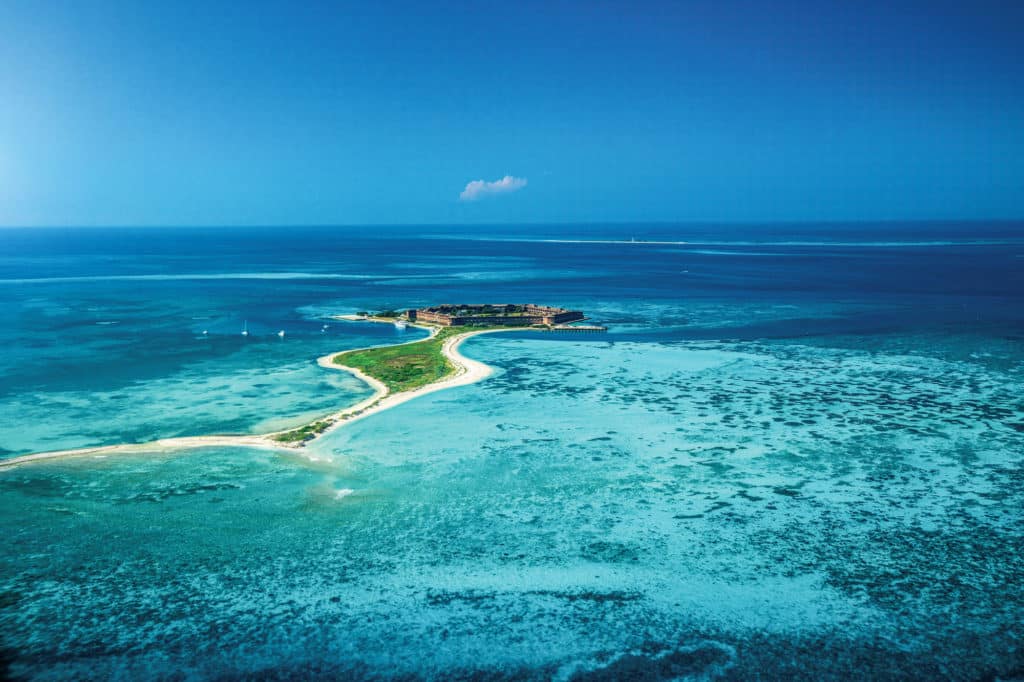
The waters surrounding Florida’s Dry Tortugas offer outstanding angling opportunities.
The ocean surface stretched like an endless pane of glass that magnified the sun’s glaring heat on this June Florida morning. Sweat poured from my brow as I slung a scoop of pre-mixed sand-and-chum gruel into the clear water behind the boat, then free-lined a chunk of bonito, a hook buried inside, allowing it to descend amid the aromatic grit. I watched it sink into the deep blue until I could see it no more. Within seconds after the bait disappeared from sight, line began to melt from the spinning reel in a spiraling blur. I closed the bail and wound tight to set the hook. Violent head shakes 100 feet below nearly wrenched the rod from my grasp. That fish is not happy, I thought to myself. For the next 90 seconds, it refused to succumb to pressure, instead boring its way deeper against the heavy drag. Now I was really sweating.
Eventually the battle turned, and I was able to gain line. From the depths emerged a silvery-pink apparition, and soon a 15-pound mutton snapper lay glistening on the deck.
That marked the start of one of the most successful fishing days of my life—all of it taking place in the waters surrounding Florida’s Dry Tortugas. We went on that day to catch multiple amberjack, blackfin tuna, black grouper, kingfish and mahi, as well as more muttons.
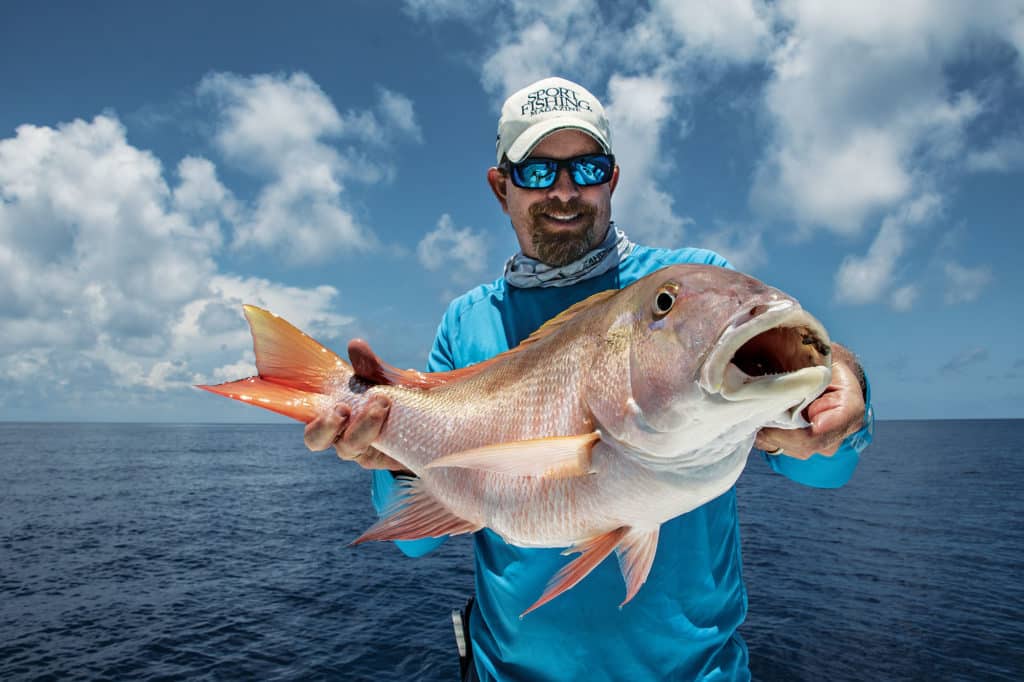
Distant Rewards
This tiny, remote archipelago lies more than 60 miles from the closest fuel dock, in Key West. The abundance of fish here beckons anglers, but the distance has traditionally discouraged many from attempting single-day trips to these waters, especially in the early days of center-console fishing boats.
Anglers with the determination to fish the Dry Tortugas needed to coordinate special logistics. Many would arrange for a mothership to carry fuel, ice and provisions, and provide overnight accommodations, then finagle a crew to abandon their normal lives and commit to three, four or more days to fish these waters. And that didn’t even include weather or financial considerations.
One of these anglers was Alex Lipworth, now owner and president of Invincible Boats, who has been fishing the waters surrounding the Dry Tortugas since 1992. “We’d mothership aboard a commercial yellowtailer,” Lipworth explains. “Then we’d stay for a week at the Dry Tortugas, fishing these waters from one or two smaller boats.”
Though not for the faint of heart, such adventures can result in spectacular rewards. “The fishing was great—and is still good,” Lipworth says. “Even today, many of these fishing spots rarely get touched, and so you can’t imagine the number of African pompano, black grouper, cobia, mangrove snapper, mutton snapper, red grouper, red snapper and other fish,” he explains.
Time Machines
Center-console fishing boats have evolved mightily in the past decade, giving rise to fast fishing machines in the 40-plus-foot range with fuel capacities exceeding 600 gallons. This goes beyond speed for the sake of speed, and size for sake of vanity. These vessels can change the concept of time for boating anglers. Now rather than planning for a trip that used to last days, anglers can think in terms of hours, even minutes.
To prove the point, we set out aboard an Invincible 40 Cat center-console with a crew of six from the Ocean’s Edge Marina on Stock Island in Key West on a June morning, and headed west. Our target: a hard-bottom area about 8 to 9 miles south of the historic Fort Jefferson on Garden Key—approximately 60 miles away.
The crew included Invincible Boats’ Bill Cordes, Zack Howell and Jonathan Lipworth (Alex’s son), along with our Key West-based guide, Capt. Chip Veach, as well as Sport Fishing group publisher, Scott Salyers, and yours truly. Alex Lipworth was scheduled to join us but was called away by work at the last minute.
Powered by four Mercury 350 Verado outboards, the 40 Cat is capable of speeds in excess of 70 mph. However, to conserve fuel, we throttled back to 55 mph en route to the Dry Tortugas—still a remarkable cruising velocity and one that felt very comfortable aboard Invincible’s largest multihull boat.
As we headed out, Veach explained that he rarely fishes so far from port aboard his boat, Super Grouper, an Invincible 33 powered by twin Yamaha F300 outboards, since he has plenty of spots to catch fish closer to home, he says.
“However, if my guests really want to catch big black grouper—and the season is open—this is the place to catch them,” he adds. “A boat like this can get you there in a hurry, and we will have plenty of time to fish.” Indeed, the 40 Cat delivered us to our fishing spot in 70 minutes flat.
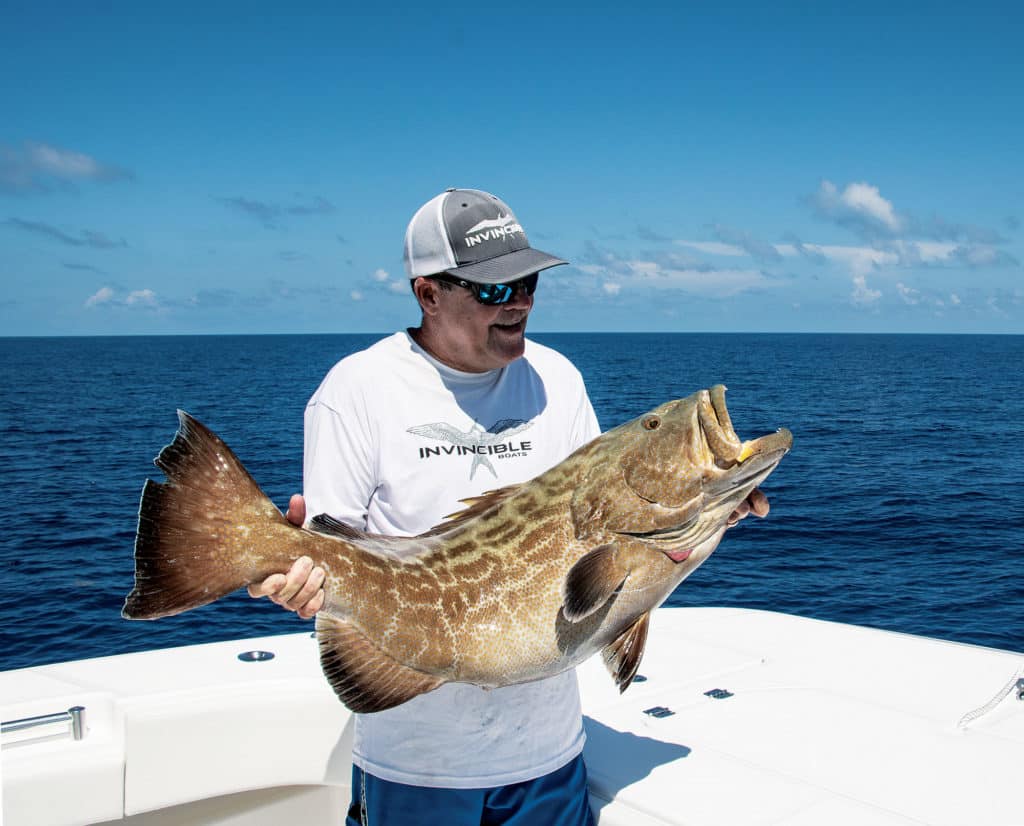
Seeing Red
Veach used the Garmin chirp fish finder on the Invincible to zero in on a hard-bottom spot in 150 feet of water, indicated by a pronounced deepening of the red bottom echo. A light yellowish‑red layer of fuzzlike returns hovered just above the seafloor.
These two factors—a thicker bottom return and a light fuzz just above it—are the keys to catching groupers and snappers, Lipworth says. “You won’t necessarily see fish on the sonar, but if you see that light fuzz above a hard bottom, you’ve found a good spot,” he explains.
The current was mild, so Veach decided to anchor the 40 Cat. He motored up-current about 200 feet, and Howell dropped the anchor. Then Veach reversed the engines to scope back and position the boat slightly up-current from the hard-bottom area. That’s when I free-lined a bonito chunk back in the current and caught that mutton, first fish of the trip.
While putting out a chum bag and occasionally tossing out some sand-and-chum mix helps, the real key to triggering bottomfish into a feeding mood is, wait for it…catching a few fish. “For some reason, once you hook a fish or two, the other snappers and groupers get very excited and move in to feed,” Lipworth explains.
However, this occurs primarily when anchored on one of the hard-bottom spots, Lipworth explains. “For some reason, the fish tend to gather under the anchored boat, and when that happens, fishing action really heats up,” he says. “That’s when you will start to see fish on the sonar.” You can set up to drift over these spots and catch fish, but not at the same pace as when you anchor, Lipworth reveals. He recommends carrying at least 600 feet of anchor line with 12 feet of chain and a Danforth-style anchor.
It took a while, but true to form, once we hooked few more muttons, the bite accelerated with a vengeance. After that, virtually every bait that went out was inhaled as it neared the bottom.
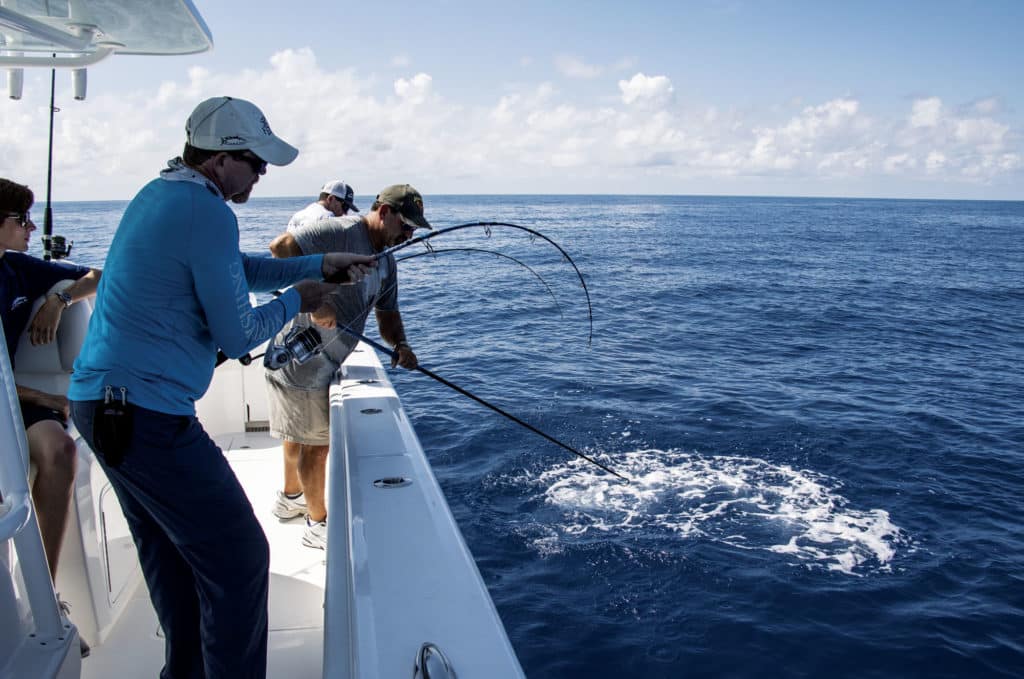
Bait Up!
While muttons and amberjack continued to eat the chunks, it took something different—a live pinfish—to entice a black grouper. It also required powerful 6-foot bottomfishing rods, Shimano Talica 20II lever-drag reels spooled with 65-pound-test braided line, and a 3- to 4-ounce sliding egg sinker ahead of a 15-foot-long 80-pound-test fluorocarbon leader with 5/0 Mustad J hook. This allowed us to fish almost vertically—a key to actually landing a big grouper once it bites.
Despite the relatively low-relief nature of the Dry Tortugas’ hard-bottom areas, most spots are festooned with snags such as low-lying rocks, gorgonian corals and ledges—all tools in a grouper’s arsenal of escape. Keeping the line as vertical as possible minimizes the opportunities for a hooked grouper to cut the line on these snags.
It was not long before a grouper inhaled a pinfish, and Cordes was up for the challenge. The rod bent nearly double, and the battle seesawed for agonizing minutes until Cordes was finally able to pry the powerful fish off the bottom. A few minutes later, we pulled a 35-pound black grouper over the rail. Since black grouper season was open, this and a few others went on ice in the fish locker.
Depth Considerations
The 150-foot depth in which we were fishing fell within the ideal range for targeting muttons, Veach has discovered. “The best depth for muttons is 150 to 180 feet,” he says.
While we did not target red snapper on this trip, this species prefers hard-bottom spots in deeper water around the Dry Tortugas, Veach reveals. “When the season is open, try fishing in 210 to 220 feet; this is where you are most likely to catch red snapper,” he says.
Depth does not prove as critical for the prized black grouper, which might occupy hard-bottom areas in depths ranging from 130 to 400 feet. One disadvantage of fishing spots deeper than 300 feet is the difficulty in anchoring, especially when a powerful current is running. In these cases, Lipworth abandons the idea of anchoring and instead motors up-current of the spot, then drops baits down and drifts over the area, using enough weight to keep the line vertical. “This is about the only way to target black grouper on the deeper spots,” he says.
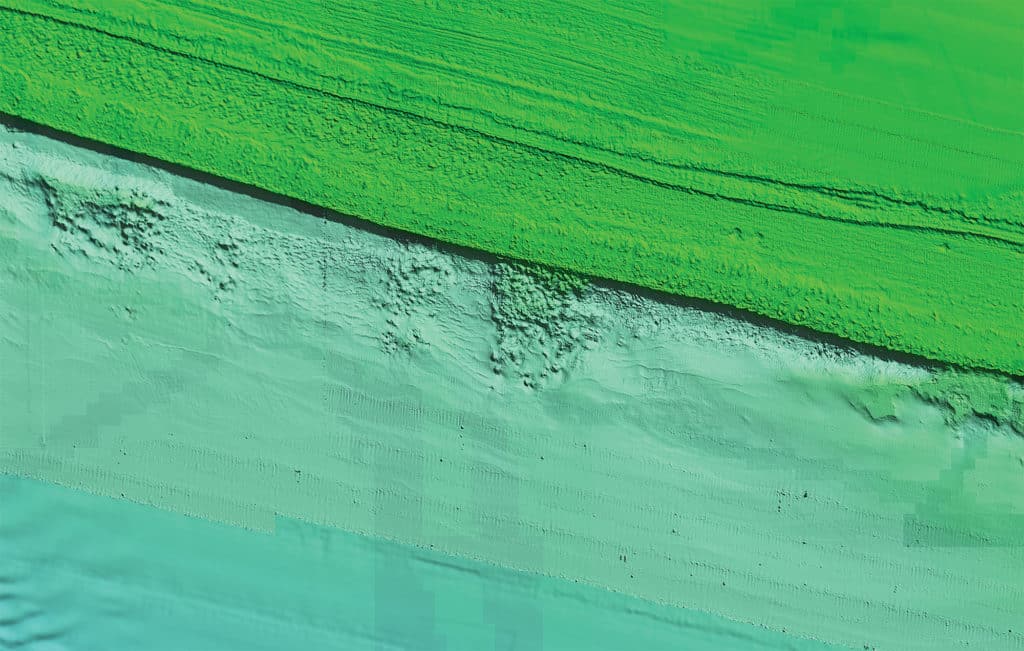
Prep for Pelagics
In addition to carrying live pinfish, Veach likes to have a livewell full of pilchards, just in case pelagic species such as blackfin tuna or mahi show while the crew is bottomfishing.
This is exactly what occurred on our trip. About an hour after we set anchor, a school of blackfin erupted off the stern. Salyers pinned on a pilchard, cast it into the melee, and was rewarded instantly. The 18-pound blackfin uncorked an initial blistering run, then dived deep, staging the characteristic circle fight before Salyers could work the fish to the surface and an awaiting gaff. We caught three more blackfin before the school vanished. Later in the morning, a group of mahi also cruised in for a visit, and a handful eagerly bit the pilchards, adding yet another species to the fish locker.
One bluewater species that often shows up on these hard-bottom spots is wahoo, but Veach does not use live bait for these speedsters. Once he eyes a wahoo swimming around the boat, he rigs a 3/0 J hook with wire leader and baits it with a bonito chunk. “Nine times out of 10, the wahoo will bite the chunk,” Veach says.
Sore and Happy
After more than three hours of reefing on powerful fish in 90-plus-degree heat, I was toast. Arms like rubber, I put down the fishing rod, rehydrated, and reflected on this lonely patch of ocean swirling around the Dry Tortugas. There was not another boat in sight, and only the thin silhouette of the lighthouse on Loggerhead Key near the historic Fort Jefferson punctuated the distant horizon.
Read Next: Boat Review: Invincible 40 Catamaran
Later, as we secured the tackle and prepped the boat for the 70-minute run back to Key West, I thought that the action could not have been much better had we been the first people ever to ply these depths. My arms ached for days after the trip, each fresh pang triggering another memory about an amazing one-day fishing trip to a remote hard-bottom spot below the waters of the Dry Tortugas.
No-Take Zones
If you decide to visit the Dry Tortugas to fish, be aware that the area hosts no-take zones, including a 46-square-mile federal Research Natural Area surrounding Garden Key. Two other nearby no-fishing zones include the federal Tortugas North Ecological Reserve north of the fort and the Tortugas South Ecological Reserve to the southwest. Fish and fishing gear must be stowed prior to entry and during transit through these areas.
If you decide to visit Dry Tortugas National Park, which includes the RNA, you need to contact park staff via VHF 16 and declare any catches brought in. Check with park staff regarding necessary permits and anchoring regulations if you plan to overnight in the park. To learn more, visit nps.gov/drto and floridakeys.noaa.gov.
Grouper and Snapper Seasons
Seasons for grouper and snapper are complex in the waters surrounding the Dry Tortugas because this area straddles the confluence of three of Florida’s ocean-management zones, as well as three no-take zones.
Suffice it to say, in the Atlantic Zone waters we fished 8 to 9 miles south of Fort Jefferson, the season for grouper—including black, coney, grasby, gag, red, red hind, rock hind, scamp, yellowfin and yellowmouth—is open from May 1 to December 31 this year.
For 2019, the two-day season for red snapper for private vessels has been set for July 11 and 12, with the season for federally permitted for-hire (fishing charter) vessels stretching from June 1 to August 1. Fishing for other species of snapper—including cubera, lane, mangrove, mutton, schoolmaster, vermillion and yellowtail—is open year-round in the Atlantic Zone waters we fished. To learn more about open seasons and limits, visit myfws.com.








